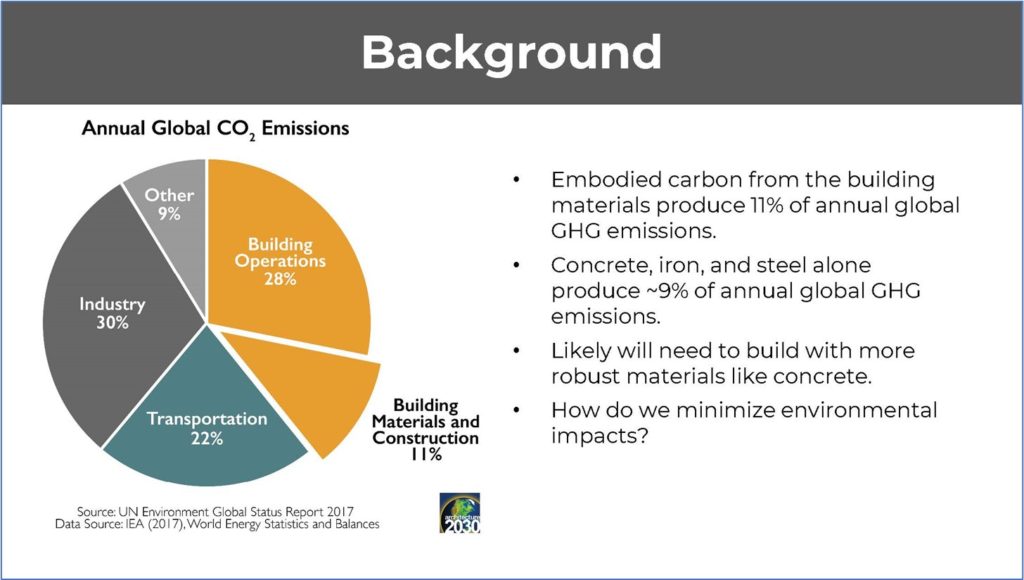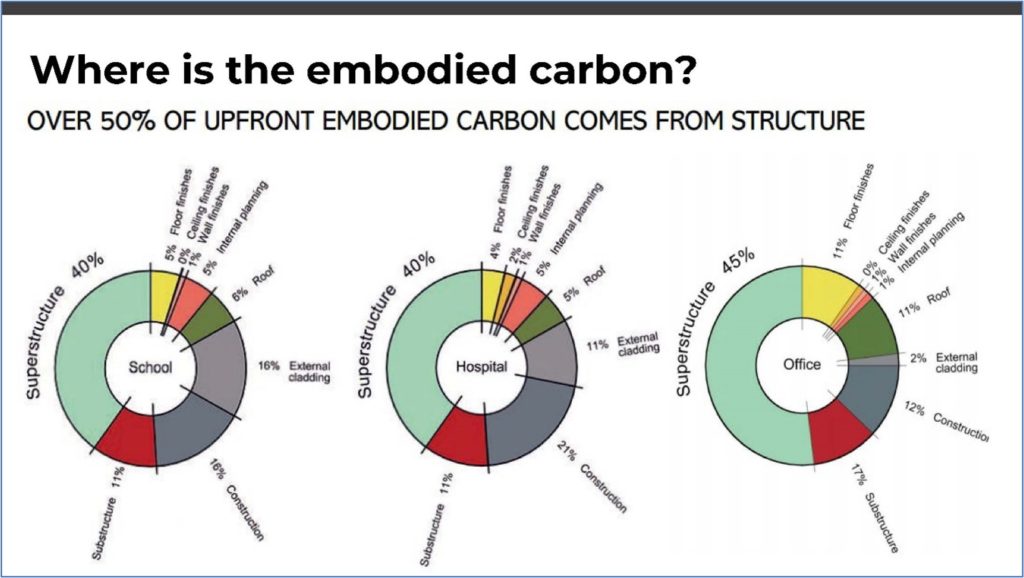Lightweight Concrete Masonry Units: A Healthy Win for Resilient, Sustainable and Carbon Neutral Building Practices
Words: Kevin Cavanaugh
Words: Kevin Cavanaugh
Photos: ESCSI, and others noted
It seems like everyone is talking about sustainability or some version thereof. News outlets are often reporting on topics like climate change, greenhouse gas emissions, net zero and the green economy.
For about 25 years now, architects, engineers, project owners, contractors and suppliers have created designs and incorporated building materials to make green buildings a reality in accordance with energy efficiency and carbon-neutral guidelines developed by the US Green Building Council’s LEED program and the American Institute of Architects’ AIA 2030 Challenge. More recently, the Structural Engineers Association adopted the SE2050 Challenge to promote, design and construct net-zero embodied structures.
Today, the design community and government entities continue to implement design and building practices in accordance with the guidelines mentioned above. What do these terms mean, and how do they impact mason contractors?
Answering the Catchall Question, “What is Your Carbon Footprint?”
Both buildings and construction materials have carbon footprints. Energy, mostly generated by burning fossil fuels, is used to heat, cool, ventilate and light buildings and to manufacture construction materials. This energy, plus the emissions resulting from burning these fossil fuels, contribute to their carbon footprints. In fact, according to the UN, building operations account for 28% of annual global CO2 emissions. Building materials and construction practices account for 11%.
 Charting the impact construction has on the environment (Courtesy of UN Environment Global Status Report)
Charting the impact construction has on the environment (Courtesy of UN Environment Global Status Report)
That said, not all emissions are the same. According to Carl Elefante, AIA’s president in 2018, “The greenest building is one that already exists.” So, it is important to consider not just the size of a building’s carbon footprint but also how it relates to its life expectancy. Structures that can withstand adverse events without requiring extensive repairs or complete rebuilds can be more sustainable, even if their initial carbon footprint is larger than less robust materials like wood. The key is resiliency.
According to the Urban Land Institute, resiliency is “the ability to prepare and plan for, absorb, recover from and more successfully adapt to adverse events.” Properly designed and built masonry structures are inherently resilient, especially when load-bearing. Moreover, masonry structures are rot and fire-resistant—and unlike a burning wood-framed building, they will not emit CO2 during a fire. They are, obviously, not a food source for termites or mold. These qualities further increase their resiliency. Masonry structures also do not emit CO2 at the end of their useful life, unlike landfilled lumber.
Because they can easily be repaired and reused after an adverse event like a hurricane, flood or fire and oftentimes do not need to be torn down and rebuilt, masonry buildings are inherently sustainable and resilient.
Use ComCheck to Meet Energy Codes, Not the R-Value Tables
Another more well-known and better-understood green term is R-Value, which is a material’s ability to resist heat flow. Getting more insulation and higher R-Values into exterior walls has long been a goal in the past but not so much today. Increasing the efficiency of HVAC and lighting systems is driving today’s improvements, not higher R-Values. Unfortunately, the momentum to use highly insulated walls with high R-Values is deeply embedded. However, this does not serve the masonry industry well. Masonry walls, especially single-wythe concrete masonry unit (CMU) walls, fulfill many functional needs. Today’s highly insulated (non-masonry) wall systems are usually built with many single-function components. It is easier and less costly for them to achieve high R-values than for masonry walls.
The masonry industry is better served by ignoring the prescriptive high R-Value requirements in energy codes and using the trade-off compliance path and easy-to-use, free ComCheck software. Nonetheless, if higher R-Values are a goal, using lightweight CMU will always help. Insulated lightweight CMU have 2-3 times higher R-Values than comparable normal weight CMU.
Dry-cast CMU Concrete Sequesters Carbon 700 Times Faster Than Wet Cast Concrete
Another newly quantified CMU benefit is its ability to sequester carbon dioxide. According to the US Geological Survey, carbon sequestration is the process of capturing and storing atmospheric carbon dioxide. All concrete sequesters atmospheric carbon through a well-known process called carbonation. Recent research conducted by the Concrete Masonry and Hardscapes Association (CMHA), formerly known as National Concrete Masonry Association, indicates the zero-slump, dry-cast concrete used to make CMU sequesters more carbon more rapidly than wet-cast ready mix and precast concretes.
Wood Framed Construction: The Truth is Controversial
Everyone knows that trees are green. However, the wood-framed structures made from them are not so much. Harvesting trees and transporting the resulting lumber to where it is used requires energy and produces carbon emissions. The Canadian Concrete Masonry Producers Association has cataloged many great resources refuting the wood industry’s green storyline. Clearcutting forests, carbon emissions from the decomposition or burning of unused scraps, and more all create strains on the environment. This, in combination with the lower resiliency wood construction offers, implies that using wood is not as green as it may seem to be—especially when a cradle-to-grave approach is taken.
The wood industry uses a cradle-to-gate approach to calculate its carbon footprint. The concrete and masonry industries, like most others, use the cradle-to-grave approach, which includes all impacts over the entire life span of a material or building and gives a more accurate picture of how construction materials affect the environment.
The Portland Limestone Cement Story
Cement accounts for approximately 8 percent of global carbon emissions. Cement, after water, is the most widely used material (of any type, construction or otherwise) on the planet and accounts for 79 percent of concrete’s carbon emissions. Concrete has a lower embodied carbon content than many other metallic construction materials, such as aluminum, copper, iron, lead and steel. But, because it is so widely used, it has a big environmental impact. Cement is now being made with finely ground limestone as one of the raw materials. Known as Portland Limestone Cement (PLC), it reduces regular Portland cement’s global warming potential by 10 percent.
 A structural system accounts for the most embodied carbon in a building (Courtesy SE 2050 Commitment Program)
A structural system accounts for the most embodied carbon in a building (Courtesy SE 2050 Commitment Program)
Lightweight CMU = Fewer Injuries & Deliveries = Less Fossil Fuel Consumed
Lightweight CMU is typically about 30-40% lighter than regular CMU. This reduces the amount of fossil fuels needed to transport them to the jobsite. More lightweight CMU can fit on a truck or pallet, which results in fewer deliveries and less fuel consumed. Further, lighter CMU mitigates the strain put on masons when laying them, and related worker’s compensation claims, creating a safer jobsite.
In addition, CMU made from expanded shale, clay and slate (ESCS) lightweight aggregates have much less crystalline silica in them—1/8 that of natural sands and 1/3 that of granite. This translates into an 83 percent reduction in crystalline silica. OSHA places limits on how much crystalline silica dust can be potentially inhaled. Using lightweight CMU made from ESCS will contribute to safer jobsites.
Become Part of the Resiliency and Climate Change Conversation
Understanding these concepts can help mason contractors lower their carbon footprints and begin to steer the conversation with their clients towards masonry-friendly carbon neutral and net zero solutions.
About The Author
Kevin currently chairs ACI/TMS Joint Committee 122 on Energy Efficiency of Concrete and Masonry Systems that is charged with developing masonry friendly national energy code standards, NCMA’s CMU Technical Committee and the Expanded Shale, Clay and Slate Institute’s Masonry Committee. He has worked for large, multi-national and small, family-owned CMU manufacturing companies and several lightweight aggregate producers. He enjoys the people in the concrete and masonry industries and educating owners, architects, mason contractors and masonry suppliers on lightweight concrete masonry’s many benefits.